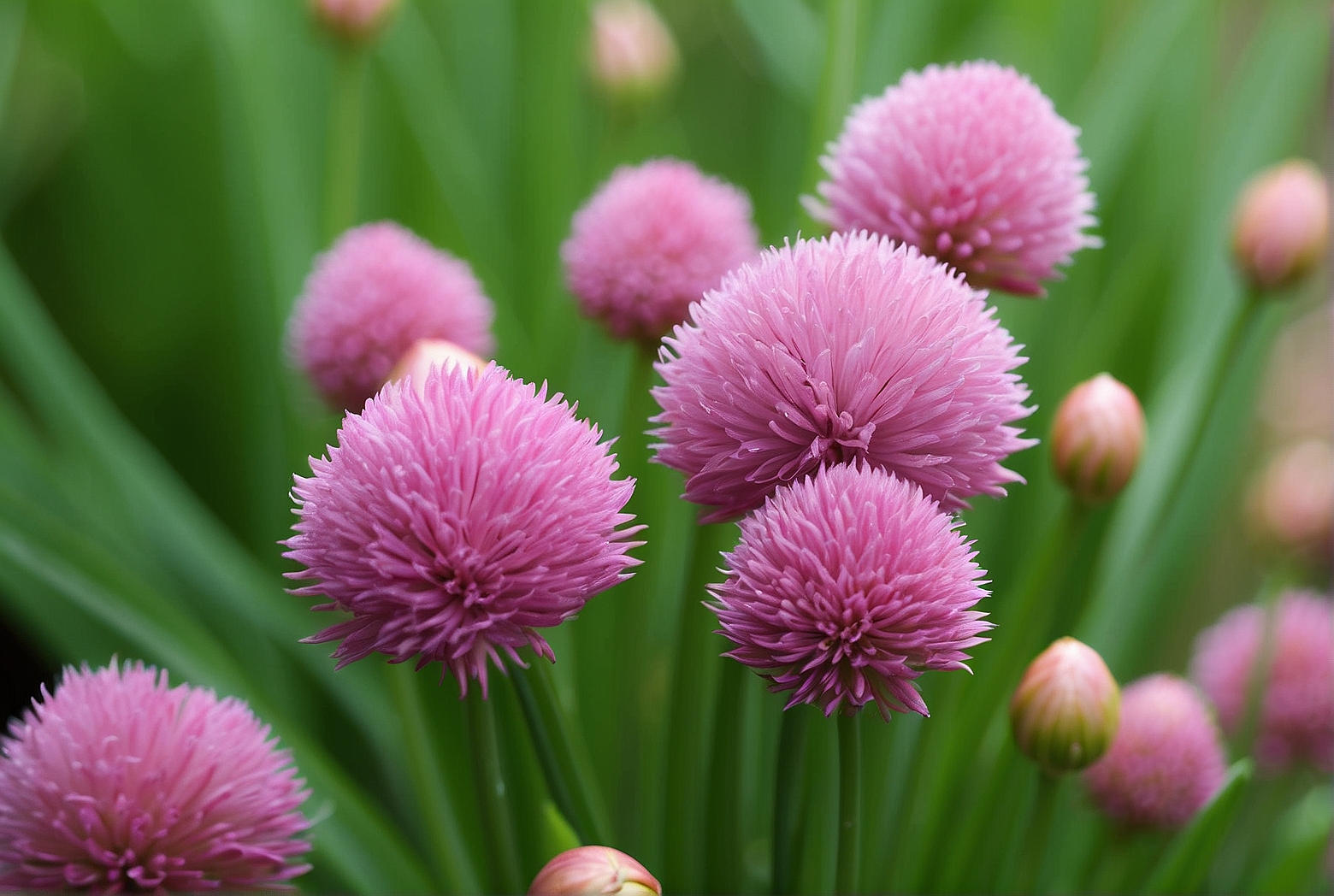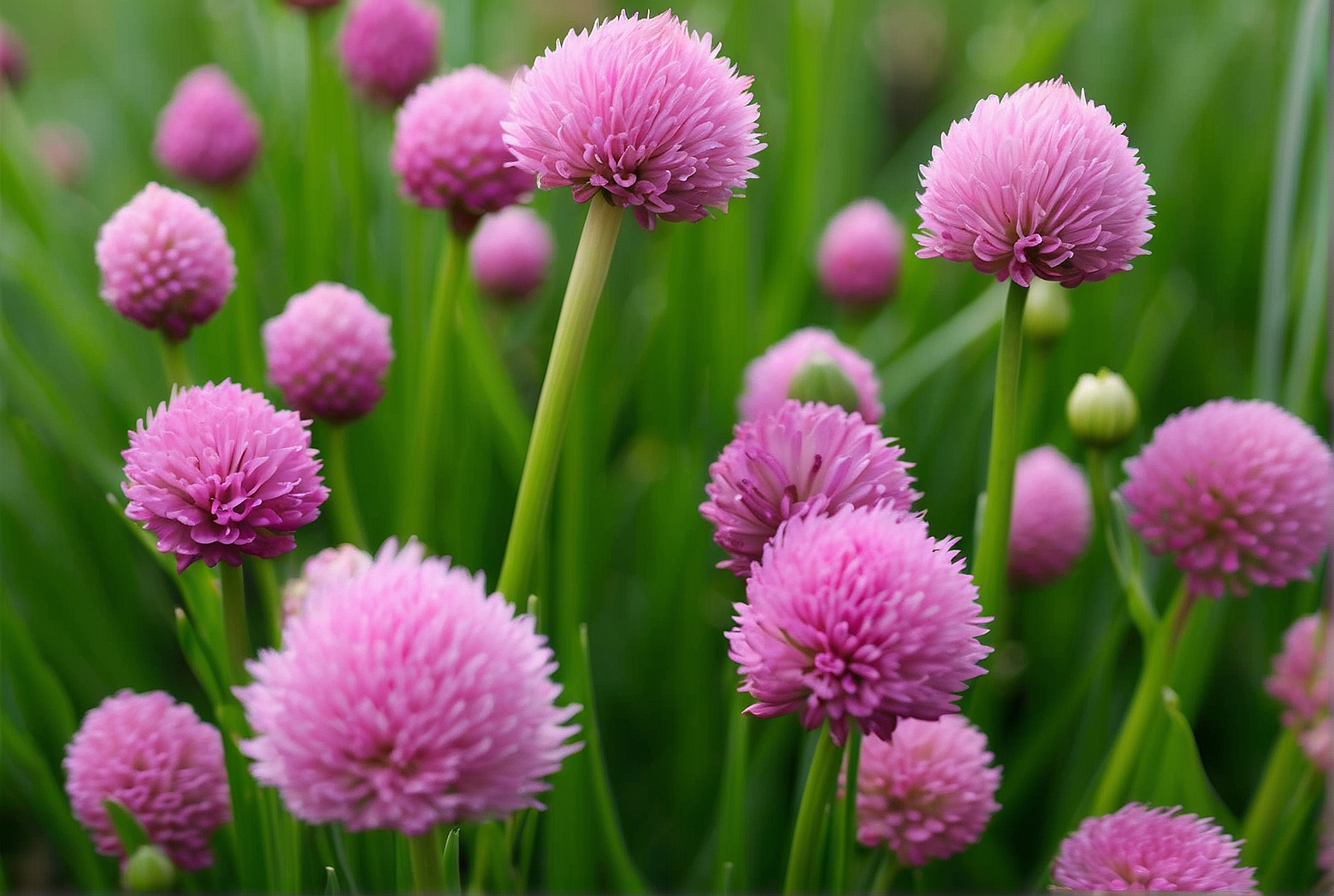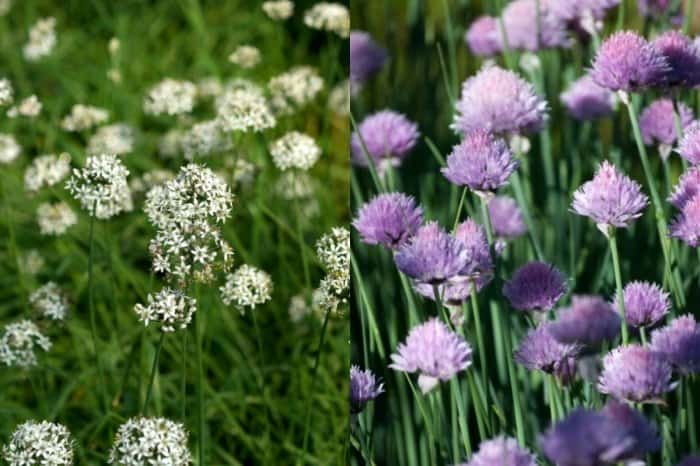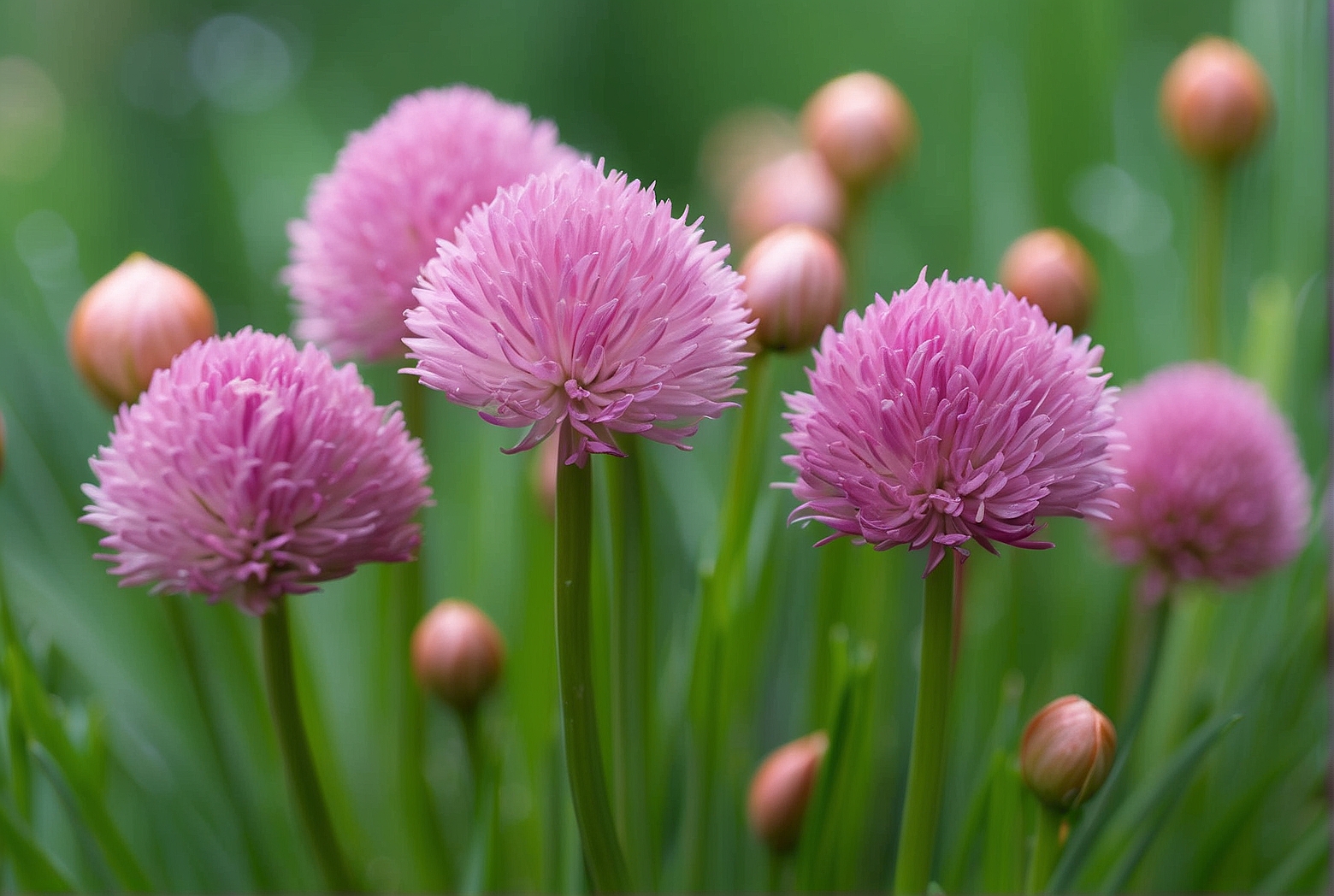Last Updated on March 27, 2024 by
Should I let chives flower is one of the most commonly asked questions by most gardeners who don’t know the right thing to do with the blooms.
Chives (allium schoenoprasum) are perennial members of the onion family. They have a light onion flavor and their hollow green leaves grace the summer salads, omelets, soups, and any other recipe that needs a hint of chives. This herb is a classic match for potato salad and versatile enough to work with any cuisine.
They sport beautiful edible flowers that are a loved delicacy. Chives are cool-season, cold-resistant perennials best planted in the early year to mid-spring for an early summer harvest.
When planting chives be mindful of where you are growing them as it will take over your garden easily especially if you allow the flowers to develop fully. Once fully developed they scatter seeds and growth starts immediately.

However, this plant is easy to dig up and move if it ends up invading other parts of your garden. Chives is a wonderful companion that discourages pests. They are a good companion plant to celery, carrots, lettuce, tomatoes, and peas.
Types Of Chive Plants To Grow
Chives have two species commonly grown in most gardens. These are the two Common chives (Allium schoenoprasum) and Garlic chives (A. tuberosum).
-
The Common Chives. These consist of clumps that have smaller and slender bulbs. They produce thin, tubular, blue-green leaves reaching 10 to 15 inches in height. The flowers are white, purple, pink, or red depending on the variety and they grow in zones 3 to 9.
-
Garlic Chives. These are also called Chinese chives and look similar to common chives but their leaves are greener, flatter, and grow up to about 20 inches in height. The leaves have a mild garlic flavor with more intense bulbs. Their flowers are white densely clustered than the common chives. They are not as hardy as the common chives and do well in zones 4 to 9.


Should I Let Chives Flower?
My chives are blooming with purple flowers, should I let them continue with the bloom or what should I do?
This is one of the many questions we get from gardeners who don’t know what to do with blooming chives. There is really no harm in letting your chives flower. Well, your harvest might get smaller if you allow it but you get to enjoy eating these flowers too.
Once chives produce flowers, their stalk gets hard and you cannot eat it. It’s like sacrificing one thing for another. The flowers are there only for a short while and you can choose to enjoy them while you can.
Did you know the entire plant is edible – the leaves, blossoms, and even bulbs. Pollinators are also attracted to the flowers of the chives making them useful in the ecosystem.
Read more about How Much Water Does Lavanda Need?
Trimming Your Chives And Their Flower For New Growth
The best way to get a good harvest and beautiful flowers is to trim the plant down. When the first flower buds are developing, trim half the tuft and leave the rest.
This way you will get the best of both worlds. One-half of the tuft will start developing flowers while the other trimmed will produce a nice fresh harvest of chives.
But Why Should You Trim?
Prune so you can grow and harvest lots of chives, but note, it’s important and beneficial to the plant. It’s a good habit to prune your chives regularly and here are a few reasons why.
-
It promotes new growth – Trimming the chives will help promote new growth on the plant. The tender new plants taste better than the older ones.
-
Keeps the plants looking nice – If you don’t prune the chives, they overgrow making the plant look woody and overgrown. Cutting them down makes the garden look neat.
-
Prevents chives from spreading – If you don’t cut back the mature chives, they will reseed very fast. It is an aggressive re-seeder and if not controlled you will have more chives than you need within a short while.
gonicc 8″ Professional Premium Titanium Bypass Pruning Shears
FAQs
Can you harvest chives after they flower?
Chives are an annual herb, so yes, you can harvest them after they have flowered. I have a small bed in my garden that has been producing for years now, and I harvest the leaves on a regular basis. You will have to watch it closely, though, because they are a biennial, and once you harvest them, they will not return.
How long does it take for chives to flower?
Chives are grown from seed and can be planted in the fall. They will flower in spring and you will need to cut the flower heads back so that they will bloom again next year. Chives have a long flowering season and can last until the end of August. What is the best time to plant chives? The best time to plant chives is in the fall, in September or October.
Chives will grow best if you give them full sun to part shade in a well-drained soil with lots of organic matter. You can start chives from seed in the fall or buy young plants.
What is the best time to plant chives?
The best time to plant chives is in the fall, in September or October. hey will grow in almost any kind of soil, but if you want to encourage them to grow, add organic matter such as compost or manure to your garden. If you decide to grow them from seed, plant them about four inches apart in a row and then thin out the seedlings so that there are two or three plants per square foot.
Should I cut back chives after flowering?
Chives are perennials, so you don't need to cut them back every year. They are also biennial, so you only need to cut them back the first year. The second year they will have more growth and you'll be able to harvest them again.
Chives have a long tap root that can go down as far as 18 inches. They are very easy to grow and require no special care or fertilizer. Chives are easy to grow and are an excellent choice for your edible herb garden.
Are chives hardy plants to grow?
Chives are hardy and easy to grow. They are perennial herbs and can be grown in containers or in the ground. You can plant them in fall, but they will need some protection from frost until spring. They can also be planted directly into the soil in spring. You can grow them in a sunny window or under a porch light or other indirect light. They do not like direct sun.
Chives are easily propagated by dividing the rootstock in fall or early spring. I have grown them successfully from seed, direct sowed into the garden and transplanted. You can also start them indoors in small pots in spring. If you have never tried growing chives, then now is a good time to give them a try. You might be pleasantly surprised at how well they do.
Chives can be planted in full sun or part shade. They prefer a soil with plenty of organic matter, which will help retain moisture and keep the soil cool. They need moist, rich soil and thrive in well-drained conditions. Chives grow best in cooler climates. They are drought tolerant once established. Plant them where they can receive the most sun.
Growing Chives Conclusion
FAQs
Can you harvest chives after they flower?
Chives are an annual herb, so yes, you can harvest them after they have flowered. I have a small bed in my garden that has been producing for years now, and I harvest the leaves on a regular basis. You will have to watch it closely, though, because they are a biennial, and once you harvest them, they will not return.
How long does it take for chives to flower?
Chives are grown from seed and can be planted in the fall. They will flower in spring and you will need to cut the flower heads back so that they will bloom again next year. Chives have a long flowering season and can last until the end of August. What is the best time to plant chives? The best time to plant chives is in the fall, in September or October.
Chives will grow best if you give them full sun to part shade in a well-drained soil with lots of organic matter. You can start chives from seed in the fall or buy young plants.
What is the best time to plant chives?
The best time to plant chives is in the fall, in September or October. hey will grow in almost any kind of soil, but if you want to encourage them to grow, add organic matter such as compost or manure to your garden. If you decide to grow them from seed, plant them about four inches apart in a row and then thin out the seedlings so that there are two or three plants per square foot.
Should I cut back chives after flowering?
Chives are perennials, so you don't need to cut them back every year. They are also biennial, so you only need to cut them back the first year. The second year they will have more growth and you'll be able to harvest them again.
Chives have a long tap root that can go down as far as 18 inches. They are very easy to grow and require no special care or fertilizer. Chives are easy to grow and are an excellent choice for your edible herb garden.
Are chives hardy plants to grow?
Chives are hardy and easy to grow. They are perennial herbs and can be grown in containers or in the ground. You can plant them in fall, but they will need some protection from frost until spring. They can also be planted directly into the soil in spring. You can grow them in a sunny window or under a porch light or other indirect light. They do not like direct sun.
Chives are easily propagated by dividing the rootstock in fall or early spring. I have grown them successfully from seed, direct sowed into the garden and transplanted. You can also start them indoors in small pots in spring. If you have never tried growing chives, then now is a good time to give them a try. You might be pleasantly surprised at how well they do.
Chives can be planted in full sun or part shade. They prefer a soil with plenty of organic matter, which will help retain moisture and keep the soil cool. They need moist, rich soil and thrive in well-drained conditions. Chives grow best in cooler climates. They are drought tolerant once established. Plant them where they can receive the most sun.
Now that we know it’s okay to allow your chives to flower, we are free to grow our own and enjoy the blooms.
You can plant your chives next to tomatoes and carrots but not near beans and peas. Chives repel aphids ad Japanese beetles; you can therefore grow them near susceptible plants.
Bunches of chives hung in the home believed to drive away diseases and evil, go ahead and hung some chives around your home.
Finally, chives are a symbol of usefulness – because everything in a chive is useful for your food!
Caroline is a gardener who loves to get down to the nitty–gritty of gardening. She proudly proclaims herself as a ‘dirt worshipper‘ and can often be found deep in the garden, covered in soil and singing to her plants. As a self–proclaimed ‘plant whisperer‘, Caroline believes that plants need love and attention just like any other living thing, and she loves to give them both. When she‘s not tending to her garden, you can often find her researching the latest gardening trends, or teaching others how to make their gardens thrive



